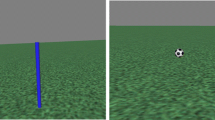Abstract
Virtual Reality is becoming more popular over the years because it allows the user to be the main actor in another environment and interact with it in real time. New interaction methods are being studied, like tangible interfaces, but there is little work done related to small distances when grabbing objects through a virtual environment. This study is important because, in our perspective, interaction in virtual reality will be at arms reach, meaning that the user will interact within very close distances (under 1 m). In this paper, the research team further evaluate distance perception using gender, the presence of avatar and height (fixed or personalised). The sample consisted of 64 participants (32 females and 32 males) evenly distributed between all four conditions (8 males and 8 females for each condition). Results revealed that gender does have an impact on small distance estimation; height does not have an impact on distance estimation; and avatar does make a difference when trying to grab a real object through the virtual environment.
Access this chapter
Tax calculation will be finalised at checkout
Purchases are for personal use only
Similar content being viewed by others
References
Fuchs, P., Moreau, G., Guitton, P.: Virtual Reality: Concepts and Technologies, 1st edn. CRC Press, Boca Raton (2011)
Koutek, M.: Scientific Visualization in Virtual Reality: Interaction Techniques and Application Development. Delft University of Technology, mathesis, January 2003
OptiTrack: OptiTrack - Motion Capture (2018). http://optitrack.com/
Piryankova, I.V., de la Rosa, S., Kloos, U., Bülthoff, H.H., Mohler, B.J.: Egocentric distance perception in large screen immersive displays. Displays 34(2), 153–164 (2013)
Williams, B., Rasor, T., Narasimham, G.: Distance perception in virtual environments. In: Proceedings of the 6th Symposium on Applied Perception in Graphics and Visualization - APGV 2009, Chania, Crete, Greece, pp. 7–10. ACM Press (2009)
Bodenheimer, B., Meng, J., Wu, H., Narasimham, G., Rump, B., McNamara, T.P., Carr, T.H., Rieser, J.J.: Distance estimation in virtual and real environments using bisection. In: Proceedings of the 4th Symposium on Applied Perception in Graphics and Visualization - APGV 2007, Tubingen, Germany, pp. 35–40. ACM Press (2007)
Creem-Regehr, S.H., Kunz, B.R.: Perception and action. Wiley Interdisc. Rev. Cognitive Sci. 1(6), 800–810 (2010)
Mohler, B.J., Creem-Regehr, B.J., Thompson, W.B., Bülthoff, H.H.: The effect of viewing a self-avatar on distance judgments in an HMD-Based Virtual Environment. Presence Teleoperators Virtual Environ. 19(3), 230–242 (2010)
Ries, B., Interrante, V., Kaeding, M., Phillips, L.: Analyzing the effect of a virtual avatar’s geometric and motion fidelity on ego-centric spatial perception in immersive virtual environments. In: Proceedings of the 16th ACM Symposium on Virtual Reality Software and Technology - VRST 2009, Kyoto, Japan, pp. 59–66. ACM Press (2009)
McManus, E.A., Bodenheimer, B., Streuber, S., de la Rosa, S., Bülthoff, H.H., Mohler, B.J.: The influence of avatar (self and character) animations on distance estimation, object interaction and locomotion in immersive virtual environments. In: Proceedings of the ACM SIGGRAPH Symposium on Applied Perception in Graphics and Visualization - APGV 2011, Toulouse, France, pp. 37–44. ACM Press (2011)
Leyrer, M., Linkenauger, S.A., Bülthoff, H.H., Kloos, U., Mohler, B.: The influence of eye height and avatars on egocentric distance estimates in immersive virtual environments. In: Proceedings of the ACM SIGGRAPH Symposium on Applied Perception in Graphics and Visualization - APGV 2011, Toulouse, France, pp. 67–74. ACM Press, August 2011
Coluccia, E., Louse, G.: Gender differences in spatial orientation: a review, vol. 24, no. 3, pp. 329–340. http://www.sciencedirect.com/science/article/pii/S0272494404000477
Naceri, A., Chellali, R.: The effect of isolated disparity on depth perception in real and virtual environments. In: 2012 IEEE Virtual Reality (VR). IEEE, March 2012
Creem-Regehr, S.H., Willemsen, P., Gooch, A.A., Thompson, W.B.: The influence of restricted viewing conditions on egocentric distance perception: implications for real and virtual indoor environments. Perception 34(2), 191–204 (2005)
Peer, A., Ponto, K.: Preliminary exploration: perceived egocentric distance measures in room-scale spaces using consumer-grade head mounted displays. In: IEEE Virtual Reality (VR), Los Angeles, CA, USA, pp. 275–276. IEEE, March 2017
Renner, R.S., Velichkovsky, B.M., Helmert, J.R.: The perception of egocentric distances in virtual environments - a review. ACM Comput. Surv. 46(2), 1–40 (2013)
Li, Z., Phillips, J., Durgin, F.H.: The underestimation of egocentric distance: evidence from frontal matching tasks. Attention, Percept. Psychophysics 73(7), 2205–2217 (2011)
Acknowledgments
This work is financed by the ERDF - European Regional Development Fund through the Operational Programme for Competitiveness and Internationalisation - COMPETE 2020 Programme and by National Funds through the Portuguese funding agency, FCT - Fundação para a Ciência e a Tecnologia within project POCI-01-0145-FEDER-028618 entitled PERFECT - Perceptual Equivalence in virtual Reality For authEntiC Training.
Author information
Authors and Affiliations
Corresponding author
Editor information
Editors and Affiliations
Rights and permissions
Copyright information
© 2019 Springer Nature Switzerland AG
About this paper
Cite this paper
Coelho, H., Melo, M., Branco, F., Vasconcelos-Raposo, J., Bessa, M. (2019). The Impact of Gender, Avatar and Height in Distance Perception in Virtual Environments. In: Rocha, Á., Adeli, H., Reis, L., Costanzo, S. (eds) New Knowledge in Information Systems and Technologies. WorldCIST'19 2019. Advances in Intelligent Systems and Computing, vol 931. Springer, Cham. https://doi.org/10.1007/978-3-030-16184-2_66
Download citation
DOI: https://doi.org/10.1007/978-3-030-16184-2_66
Published:
Publisher Name: Springer, Cham
Print ISBN: 978-3-030-16183-5
Online ISBN: 978-3-030-16184-2
eBook Packages: Intelligent Technologies and RoboticsIntelligent Technologies and Robotics (R0)




